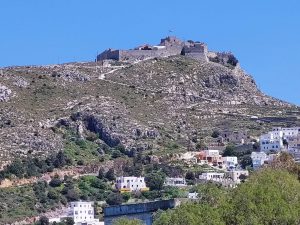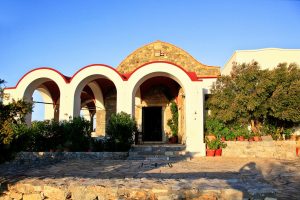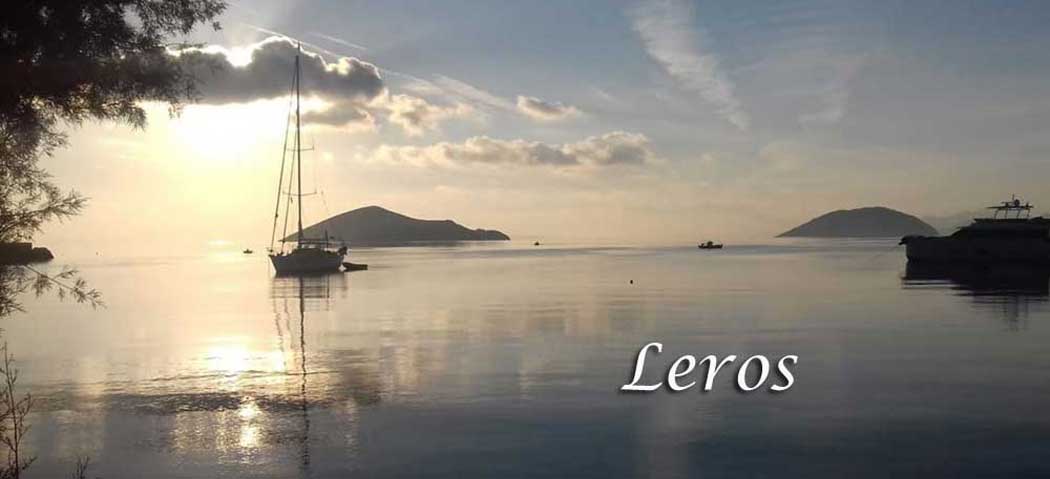Leros Castle a Byzantine fortress

In a golden decree of the emperor Alexios I Komnenos dated 1087 which is preserved in the Monastery of Patmos, the Castle of Leros is found under the name Panteliou Castle and is built on the foundations of an Ancient Acropolis, while its current form was shaped by the Knights of Agios Ioannis after its Byzantine founders.
A symbol of Leros, the castle in Panteli offers a wonderful view. At the end of the 11th century, the Byzantine emperor Alexios I Komnenos donated the Byzantine castle to Saint Christodoulos of Patmos as a share of the monastery of Saint John the Theologian (the inhabitants who were forced to leave it fled to Paleokastro, in the southern part of the island).
During the crusades, in the 15th century, parts of the Byzantine fortifications were strengthened and the outer enclosure of the castle was built, the two inner enclosures date back to the Middle Byzantine Times.
Of the castle’s churches, the Holy Trinity was perhaps founded in the Middle Byzantine Times, it has 15th century frescoes, while the rest were built during the Chivalry. Panagia tou Kastro was built around the end of the 17th century.
The miracle with the icon of Virgin Mary
On December 24, 1522, after the siege of Rhodes, a treaty was signed between Sultan Suleiman the Magnificent and the Grand Lord of the Knights Philippe Villiers de L’Isle-Adam and Leros, together with all the Order’s possessions in the Aegean, passed to Ottoman hands so the Ottomans reached Leros and settled on the island.
One morning, the Ottoman soldiers of the Castle saw far away in the bay a boat sailing alone and approaching the port of the island, so they sent a detachment and when the boat approached they saw inside the image of the Virgin Mary alone and to her right and left they burn two candles.
They then called the priests of the island who went to the port together with many residents after the event was learned, they took the icon and transferred it to the metropolitan church of Leros, possibly to the church of Agia Paraskevi.
In the place where the present church of Panagia is located in the Castle, at that time there were military warehouses of the Turks who guarded their gunpowder warehouse (barutkhane) and one morning when they opened the door of the warehouses, the Turkish soldiers were surprised to see on a barrel the image that they had delivered to the priests and had placed in the metropolis with the two candlesticks lit on the right and on the left.
They informed their commander and he got angry as he assumed that their soldiers were bribed by the Greek priests to take the icon to the warehouse, so he sent the image back to the Metropolis again but this happened again 3-4 times and the Turkish commander furiously takes the keys from the soldiers and having chained the door of the warehouse, locked it and took the keys himself.
The next morning, however, when he himself opened the door of the warehouse, he was surprised to see the image on a barrel with the candles lit and exclaimed: Miracle!! and after that he gave the permission and the church was built which today houses the icon of Panagia tou Kastrou while according to another tradition the icon arrived in the same way on the island of Leros during the era of the iconoclasm.
The church of Panagia on the Castle

Within the grounds of Leros Castle there is also the church of the Holy Trinity with some fragments of 9th century frescoes, the church of Agios Nikolaos and a medieval church recently dedicated to the “Unknown Christian Martyr”.
The miraculous icon of the Virgin Mary is of the Odigetria type, small in size, it is covered with silver and silver, made in 1732, but also the date of its creation, 728, while it is suspected that it is the work of Luke the Evangelist.

